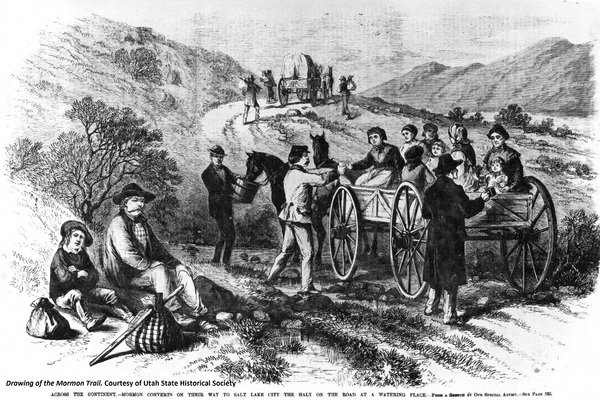Dublin Core
Title
Description
The belief that there was no future for the LDS Church in the East motivated the Mormon exodus West, to the far side of the Rocky Mountains. But how did the Mormons know where they were going?
The Mormon migration that began in 1847 has distinctly shaped Utah’s history. But how did LDS Church leaders choose this place as their ultimate destination?
As early as 1832, church founder Joseph Smith predicted that Mormons would settle in the Rocky Mountains. Conflicts with their neighbors had already forced them to relocate from New York to Ohio, to Missouri, and to Illinois. When Smith died in 1844, the Mormons faced yet another exit.
Brigham Young, who assumed leadership after Smith, aimed to move the church far away from its detractors. But where? Church leaders studied several potential sites – including Oregon, Texas, Vancouver Island, California – and focused on locations in the West where Mormons could govern themselves in isolation. They relied heavily on John Frémont’s 1843 Western expedition report, which included information about the valley of the Great Salt Lake. Another resource was Lansford Hastings' 1845 Emigrants’ Guide to Oregon and California, which promoted a new route through that same valley.
As more information became available, Mormon leaders had to rethink their options. Oregon might be too far north – both Frémont and Hastings noted the trouble of planting above the 42nd parallel. And by 1846, Texas had been annexed by the United States and was embroiled in a war with Mexico. Although the valley of the Great Salt Lake was claimed by Mexico and inhabited by Indians, church leaders decided to establish a new settlement there and use it to stage further colonization.
Young led the migration West, and along the way continued to seek the latest maps and information from other travelers. Still, Mormon leaders remained uncertain about the ideal location for their community until Young entered the Salt Lake Valley in July 1847 and famously declared, “This is the right place.” The pronouncement echoed the prediction of Joseph Smith fifteen years earlier. Even so, it wasn’t until they vetted the site over winter that they finally decided to stay.
Creator
Michelle Hill for Utah Humanities © 2015
Source
Image: Mormon converts on their way to Salt Lake City halt on the road at a watering place. Drawing of Mormon Trail. Courtesy of Utah State Historical Society.
_______________
See Lewis Clark Christian, A study of Mormon knowledge of the American far west prior to the exodus (1830- February, 1846), MA Thesis, Brigham Young University, 1972 (see appendices for maps known by Mormon leaders); Lewis Clark Christian, A study of the Mormon westward migration between February 1846 and July 1847: with emphasis on and evaluation of the factors that led to the Mormons' choice of Salt Lake Valley as the site of their initial colony, PhD Dissertation, Brigham Young University, 1976; Lewis Clark Christian, “Mormon Foreknowledge of the West,” Brigham Young University Studies 21 (Fall 1981), pp 403-415; Ronald K. Esplin, “'A Place Prepared': Joseph, Brigham and the Quest for Promised Refuge in the West,” Journal of Mormon History, Vol. 9, 1982, pp 85-111; Evening and Morning Star (Independence, Missouri), June 1832, p 6; Richard H. Jackson, “Great Salt Lake and Great Salt Lake City: American Curiosities,” Utah Historical Quarterly, Vol. 56, Number 2, 1986, pp 128-147; Nauvoo Neighbor, October 30, 1844 (vol. 2 no. 27), February 26, 1845 (vol. 2 no. 43), September 24, 1845 (vol. 3, no. 21); Robert E. Parson, A History of Rich County, Salt Lake City: Utah State Historical Society, 1996, pp 39-41; Times and Seasons, December 1, 1845, VI, 1046.
Publisher
The Beehive Archive is a production of Utah Humanities. Find sources and the whole collection of past episodes at www.utahhumanities.org
Date
2015-02-13

